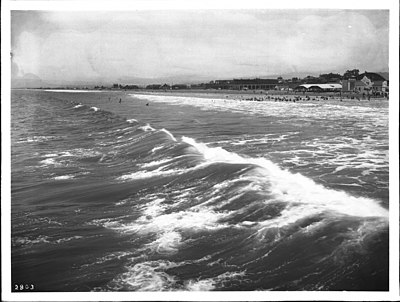San Pedro Bay (California)

San Pedro Bay is an inlet on the Pacific Ocean coast of southern California, United States. It is the site of the Port of Los Angeles and the Port of Long Beach, which together form the fifth-busiest port facility in the world (behind the ports of Shanghai, Singapore, Hong Kong, and Shenzhen) and the busiest in the Americas. The Los Angeles community of San Pedro borders a small portion of the western side of the bay.[1][2][3] The city of Long Beach borders the port on the eastern side of the bay. The northern part of the bay, which is the largest part of the port, is bordered by the Los Angeles neighborhood of Wilmington.[4]
Seabed
Most of the bay is between 32 and 75 feet (10 and 23 m) deep. The seabed near Long Beach has experienced considerable subsidence as a result of oil extraction in the Wilmington Field from the 1950s onward. This helped the Port of Long Beach surpass the Port of Los Angeles as the leading port in the United States for a time in the 1980s and 1990s, since the deeper seafloor meant that Long Beach could accommodate ships with deeper drafts than could Los Angeles. Dredging operations related to the construction of a gigantic new marine terminal at the Port of Los Angeles have since made both sides of the bay accessible to even the largest existing container ships. Concerns regarding subsidence increased until Operation "Big Squirt", a water injection program, halted any progression of sinking land in 1960.[5]
Islands
Natural islands in San Pedro Bay include
Four small artificial islands containing oil wells (the THUMS Islands) are scattered around the bay near Long Beach. The oil drilling equipment itself is masked by tropical landscaping, architectural features and fake high-rise "buildings" in an attempt to improve their appearance from shore. These islands, named Oil Islands Freeman, Grissom, White, and Chaffee, are named for Theodore Freeman, the first NASA astronaut to die during flight, and for Gus Grissom, Ed White, and Roger B. Chaffee, who were killed by a fire during the Apollo 1 mission.[11]
Free Harbor Fight

As Los Angeles developed as an economic and trading hub, the need for a deep harbor became apparent. In the late 1890s, the
Breakwaters
Three breakwaters extend 8.5 miles (13.7 km) across most of the bay, with two openings to allow ships to enter the Port of Los Angeles and the Port of Long Beach. The first section of the San Pedro Breakwater was constructed between 1899 and 1911 at San Pedro. The Rivers and Harbors Act of 1930 authorized further construction.[13] The middle breakwater began construction in 1932.[13] The 2.5-mile eastern breakwater, also known as the Long Beach Breakwater, was constructed between 1941 and 1949.[13][14]

The western and middle breakwaters provided the ports considerable protection in the 1939 California tropical storm. With the eastern breakwater not yet constructed, coastal neighborhoods of Long Beach such as Belmont Shore were severely impacted.[15]

Restoration
The Long Beach breakwater is the target of controversy within the harbor towns and
A short documentary addressing the issues surrounding the reconfiguration of the Long Beach breakwater is available.[18]
See also
- Port of Los Angeles
- Terminal Island
- Long Wharf (Santa Monica)
- Los Angeles Harbor Light
- Long Beach Light
- Dominguez Channel
References
- ^ "Why Did a 1542 Spanish Voyage Refer to San Pedro Bay as the 'Bay of the Smoke'?" by Nathan Masters, March 28, 2013
- ^ sanpedrobayhistoricalsociety.com
- ^ waterandpower.org, Early Views of San Pedro and Wilmington
- ^ "Map | Wilmington Neighborhood Council". Retrieved September 11, 2020.
- ^ White, Michael D. The Port of Long Beach, p. 89.
- ^ "Water and Power Associates". waterandpower.org. Retrieved September 11, 2020.
- ^ Gnerre, Sam (November 5, 2018). "South Bay History: The Islands of L.A. Harbor – Smith's Island and Mormon Island". Daily Breeze.
- ISBN 978-0-520-95334-5. Retrieved August 16, 2012.
- ^ Mark Denger. "Historic California Posts: Naval Air Station, Terminal Island". Retrieved August 16, 2012.
- ^ "LA Port Plan Makes Terminal Island Preservation a Key Goal". National Trust for Historic Preservation. Retrieved January 19, 2014.
- ISBN 978-0-295-97558-0. Retrieved August 16, 2012.
- ^ portoflosangeles.org, Cabrillo's Legacy, History
- ^ a b c "Port of Long Beach History Timeline". polb.com.
- ^ gazettes.com, "Port History: From Swamp to International Trade Hub", by Jonathan Van Dyke, Staff Writer, June 22, 2011
- ^ Grobaty, Tim (September 25, 2019). "The Lash of St. Francis whipped the shores of Long Beach 80 years ago". Long Beach Post News.
- ^ Scauzillo, Steve "Making waves: Can a change in the breakwater bring back surf to Long Beach?" Long Beach Press Telegram Environment. 25 August 2013
- ^ City of Long Beach "Breakwater Reconnaissance Study" webpage accessed 22 November 2013
- ^ "Mother Wants Her Beauty Back"
Further reading
- Fries, Amos A. (October 1907). "San Pedro Harbor". Out West. XXXVII (4). Los Angeles: Out West Magazine Company: 301–351. Retrieved June 27, 2010.

